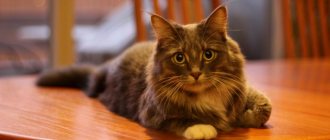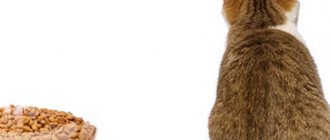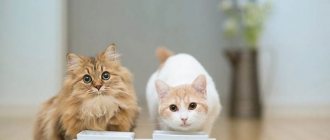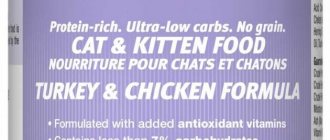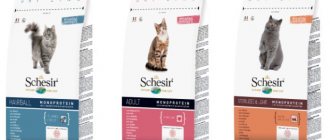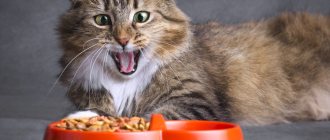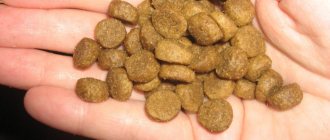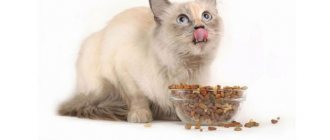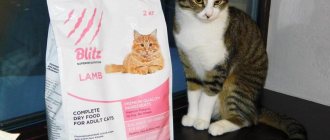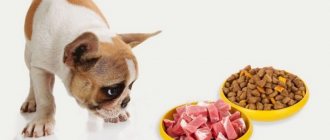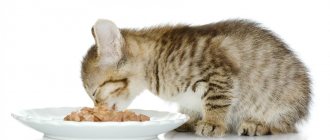Some cats are predisposed to gastrointestinal disturbances, which manifest as diarrhea or vomiting. Typically, intolerance is caused by wheat or corn gluten. There may be cases of allergic reactions to different types of meat. To protect the pet from health problems, the owner will have to choose the optimal food, which is labeled as such: for cats with sensitive digestion.
When is a cat prescribed food for sensitive digestion?
Digestion in cats depends on the characteristics of the body and even on the breed. Problems with the gastrointestinal tract can be congenital or acquired - at any time they can arise in a cat that had no prerequisites before.
If there is a malfunction in the digestive system, the pet will experience the following symptoms:
- diarrhea or constipation;
- nausea and vomiting;
- abdominal cramps, which may cause the animal to curl up and meow;
- the appearance of “dandruff” in the coat, especially at the base of the tail;
- dulling of fur;
- decreased mobility.
If these symptoms appear, it is necessary, without wasting time, to contact a veterinarian who will conduct research, prescribe treatment and help you choose a special food. It is possible that drug treatment will be required at first.
Another reason for switching to food for animals with sensitive digestion is allergies. A cat may react negatively to simple foods, but it is good to take products from the Sensitive line.
The third option is that while the cat is on a therapeutic diet, the veterinarian prescribes easily digestible food. Wet or soaked dry sensitive food is ideal for such cases.
Protein sources
Animal proteins are necessarily the main component of a cat’s natural diet. They most often serve the following types of meat:
- poultry - chicken, turkey, some parts of duck;
- beef;
- rabbit and lamb meat;
- for kittens, it is desirable to have puree or small pieces of meat with vegetables;
- low-fat varieties of fresh sea fish.
Meat and fish can be used both raw and boiled. In the latter case, it is necessary to remove all the bones, otherwise they can damage the walls of the stomach, intestines, esophagus, and larynx.
When feeding raw meat, it must first be thoroughly frozen, preferably in industrial refrigeration chambers at a temperature of about -40 °C. Or keep for at least three days in household freezers.
After defrosting, be sure to rinse thoroughly with plenty of clean running water.
Fish should not be given to cats at any age more than once or twice a week.
What is the difference between diet food and regular food?
Each food has its own characteristics: both in composition and in the set of microelements. Thus, dietary foods have special compositions in accordance with different animal health issues.
Dry
The main difference between dietary dry food and regular food is its structure and composition. Animals with digestive problems often have difficulty digesting dense food textures, but they still need to sharpen their teeth (chew hard things) and maintain nutritional balance. Therefore, dietary dry food has a structure that allows the granules to quickly soften when entering the stomach and not create heaviness and lumps. For the same purpose, the granules are made a little smaller.
The second nuance is the composition, which harmoniously combines an increased amount of protein and fiber. This necessarily includes vitamins, microelements, and sometimes medications that improve digestion.
Dry food is the most affordable, plus it is convenient to store and does not need to be prepared. The maximum that is required is to soak the granules if the animal has problems with its teeth or jaw.
Wet
Dietary wet food differs from regular food in its higher water content. This is a very important feature, since the main condition of the diet for cats with weak or problematic digestion is the consumption of large amounts of liquid. The cat must actively drink, but it cannot always be forced to do so.
Wet food allows the animal to replenish its water balance. In addition to more liquid, the food may contain special medications or additives similar in principle to human dietary supplements. Dietary meats and soft foods are also used.
Wet food usually comes in two forms:
- pate (in a tin);
- pouch (in a bag).
The main disadvantage of wet food is that it cannot be stored open. If the animal does not eat the entire portion, the leftovers will have to be thrown away. For cats who eat little due to poor health, it is better to choose small jars or bags.
The structure and features of the digestive system in cats
1. Cats do not have oral digestion. Cat saliva does not contain enzymes responsible for pre-digestion. A cat's teeth are cutting teeth; they are adapted not for chewing food, but for biting it into small pieces. Cats' saliva contains more mucus than other carnivores. This allows them to swallow dry food more easily. The cat's esophagus contains additional glands that produce mucus to quickly pass this food into the stomach.
2. Cats have an incredibly acute sense of smell. The smell of food is often more important to a cat than its taste. By smell, a cat can determine not only the freshness of the food, but also its fat and protein content. This feature helps cats avoid poisoning, but because of it, cats who lose their sense of smell (if they have rhinitis, for example) may refuse to eat.
3. Gastric juice in cats is very acidic, it has a pH of 1-2 (for comparison, in humans the pH of gastric juice is 2-4). Such an aggressive acidic environment is necessary for the digestion of rodent carcasses and kills most microorganisms that enter the cat’s body with food.
4. Cats have a relatively short gastrointestinal tract. In nature, they feed quite often, in small portions.
5. The intestinal microflora of a cat differs from that of humans in having less species diversity. The number of microbial cells in the intestinal contents is also noticeably lower than in humans. This indicates that cats are adapted to a narrower range of food intake.
6. Cats are obligate carnivores. They digest proteins and fats well and carbohydrates much worse. A diet containing more than 25% carbohydrates in dry matter can cause diarrhea in a cat.
7. Cats are very picky about the quality of protein in their food. Their metabolism is adapted to feeding on small game: rodents and birds, and the prey must certainly be freshly caught. Because of this, domestic cats eat warm food with great appetite and are reluctant to finish food that has had time to sit in the bowl.
8. The cat’s body is not able to synthesize a number of vital substances on its own. The cat must get them from food. These include: arginine, taurine, arachidonic acid, vitamins A and D.
9. The cat's body does not tolerate hunger well. When fasting for more than 48 hours, a cat may begin to develop fatty liver disease (lipidosis).
10. Cats in nature hunt alone and also prefer to eat alone. If the bowl is placed in a room that seems too restless to the cat, it will tend to take the food elsewhere. This may look funny to owners, but in reality the animal is doing this because it is stressed.
11. Cats are very conservative when it comes to food. Having become accustomed to one type of food, many of them are extremely reluctant to move on to eating another. With a balanced diet, lack of variety in the diet does not cause them any harm.
12. Cats are able to set their own feeding schedule and the size of the portion they eat. They can follow such a routine very strictly and experience stress when it is violated.
How to calculate the portion of food per day
You need to calculate the amount of food based on several factors: the cat’s age, its weight, activity and breed. Usually the manufacturer prints a table on the packaging that helps calculate the weight of a serving per day. The owner divides this weight into an equal number of meals.
The daily norm for kittens up to six months is calculated proportionally according to the principle: a larger amount of food relative to body weight, with age it decreases. Babies need to be fed at least four times a day.
Feeding standards differ for cats that eat only dry or only wet food. Sometimes owners feed their pets both. In this case, it is better to make the correct calculation together with a veterinarian.
Approximate calculation of the amount of dry food per day:
| Weight, kg) | Daily serving (g) | Kitten age (months) | Daily serving (g) |
| 3 | 45 | 1-2 | 30-50 |
| 4 | 55 | 2-4 | 40-65 |
| 5 | 65 | 4-6 | 55-70 |
| 6 or more | 12 g per 1 kg of weight | 6-12 | 60-80 |
Approximate calculation of wet food per day:
| Weight, kg) | Daily requirement (g) | Kitten age (months) | Daily requirement (g) |
| 3 | 190-200 | 2-3 | 170-210 |
| 4 | 230-240 | 3-6 | 210-300 |
| 5 | 250-260 | 6-9 | 210-300 |
| 6 or more | 300 | 9-12 | 170-255 |
If the cat is very active, the daily portion can be increased by 15-20%. The opposite situation: animals suffering from excess weight are fed a little less. The same applies to older cats whose appetite decreases.
A fat predator is a sick predator
Let's remember how the cat was intended by nature. It's the perfect killing machine (let's face it), the perfect hunter, the perfect predator.
The cat was created to hide prey and hunt from ambush. But try to quickly jump out of cover if you have a fat shell dangling from you - at best - half of your own weight! How can you hide from enemies if you can’t get through any cover? How to climb a tree? Answer: with difficulty or not at all.
Let's leave the wild, what about home conditions? And at home, the owners are touched: the cat is fat, round, cozy, the mimemeters are crackling, the subscribers are squeaking. The cat eats regularly and gets fat just as regularly. But what is happening inside the cat at this very time? Unrest is growing. Why is that? Because the cat accumulates fat.
From a biology textbook we know that the body needs fat. Fat is the protection of internal organs from prolapse and injury, a source of heat and a supply of nutrients. In mammals, there are two types of adipose tissue: brown and white fat.
Brown fat is “healthy” fat. Among animals, brown adipose tissue is best developed in those that hibernate in winter. During hibernation, the body's metabolism slows down, making it impossible to maintain body temperature through skeletal muscle contractions. Cats do not hibernate, but brown fat provides them with warmth (remember - there is warmth inside the cat? Now, this is about brown fat!) and protection of internal organs. There is no need to get rid of brown fat; the cat must be of optimal weight.
White fat , found under the skin and between muscles, is a strategic store of nutrition, a source of energy, the body's defense and the place where hormones are produced. It would seem that there are only advantages, and there should be as much fat as possible. BUT.
Firstly, fat tends to accumulate toxins. If you feed your cat the wrong diet or food from your table, toxins enter the liver and fat. In other words: the wrong diet sets off a time bomb.
Secondly, try to put on an old sheepskin coat or sheepskin coat in warm weather, and then climb the stairs in this outfit. You will feel at least uncomfortable. Fat cats, by the way, experience approximately the same sensations: they are hot, heavy and uncomfortable.
Mustachioed fat men suffer from heart, kidney, liver, pancreas, and joints: the organs were designed for other design capacities, but here you have to work, relatively speaking, for two (this is at best).
To a greater extent, obesity harms metabolism and peristalsis. The fact is that a cat’s structure is quite simple - its general physical activity stimulates the functioning of its intestines. An overweight cat, as a rule, lies or sits more, and the intestines become “lazy.” The tendency to constipation in older obese animals can be life-threatening.
In addition, obesity in cats causes complications during childbirth, reduces the effectiveness of the immune system and increases the risk of malignant neoplasms.
What food additives and ingredients in food can harm the animal?
Select food for a sick pet more carefully. If there are already any health problems, the animal cannot eat low-quality food.
- Propyl gallate. This preservative is considered a harmful additive for all animals without exception. It is strictly contraindicated for dogs with stomach, kidney and liver problems, as well as for pets prone to allergies.
- Corn. A poor source of carbohydrates, difficult for the stomach to digest.
- Artificial additives Ethoxyquin, BHA, BHT, Propylgallate. Various international authorities are suspicious of this type of substance. There are studies that prove a direct connection between premature aging of dogs and the consumption of these components.
- Artificial dyes. High risk of irritation.
- Sugar. Animals are not allowed to give sweets at all, in any form and under any pretext.
Causes of indigestion
No matter how diverse the factors that disrupt the normal functioning of the stomach, I would like to separately note that an animal that eats properly and regularly, undergoes vaccination and deworming on time, and lives with loving owners, has minimal chances of developing dyspepsia.
The following factors can contribute to indigestion in a cat:
- sudden change in diet;
- irregular meals;
- low-quality food (cheap or expired food, food from the table);
- use of certain medications (non-steroidal anti-inflammatory drugs, some antibiotics);
- stress;
- infectious diseases (for example, panleukopenia);
- parasitic diseases (helminths and protozoa);
- systemic pathologies (including renal and liver failure);
- neoplasms of the digestive tract;
- changes in the functioning of the pancreas, liver and gallbladder;
- inflammation of the intestinal tract;
- foreign bodies in the stomach.
Natural feeding
Natural nutrition for a cat with gastritis should be based on the following components:
- fresh lean and easily digestible meat;
- low fat fermented milk products (1–9%);
- in small quantities bran, finely chopped raw non-starchy vegetables or fresh sprouted grass for cats.
Meat and dairy products should be given at different feedings; the latter should be excluded from the diet if they cause loose stools. The meat must be cleaned of skin and bones and cut into small pieces. It is undesirable to feed only white meat.
Bran or vegetables in the diet act as a source of fiber and carbohydrates and should be added in minimal quantities; in case of diarrhea, they should be temporarily excluded.
Despite the apparent naturalness of the ingredients, the owner of an ordinary city apartment cat who buys meat at the market or in a store cannot be completely sure that the diet is balanced in terms of the amount of nutrients.
Doing this on your own is quite difficult, as it requires lengthy calculations using tables of nutritional components and animal needs. The best option would be to contact a highly specialized veterinary nutritionist. If this is not possible, then ready-made diets come to the rescue of the owner.
Symptoms of gastrointestinal disorder
One of the signs is vomiting. But this does not mean at all that this particular sign reliably indicates a gastrointestinal disorder. Perhaps the cat ate something inedible, fatty, or something that is difficult for its stomach to digest. After all, it could simply be due to fur after being licked. Here you need to observe her condition and mood.
We suggest you read: This behavior of a dog during heat has its reasons
Diarrhea is another sign that something is wrong with your cat's health. But here, too, it is necessary to take into account some factors that could provoke this:
- Change of food.
- If the cat is walking, it could pick up something on the street. For example, she could rummage through trash containing spoiled food.
- Even at home there can be objects that, when ingested, cause diarrhea.
Diarrhea normally lasts no more than a day. A longer state of weak stool is a disruption of the gastrointestinal tract.
Foods that are good for the stomach and stimulate the gastrointestinal tract
In some patients, most often the elderly, intestinal motility deteriorates and the person begins to suffer from constant constipation. But there are foods whose consumption stimulates gastric and intestinal motility, which improves digestion and reduces the likelihood of constipation. These foods that are good for the stomach include:
- Fermented milk products (kefir, fermented baked milk, cottage cheese).
- Vegetables: pumpkin, beets, carrots, sauerkraut. You can have vegetable soups, but only without meat.
- Fruits: melon, apple, plum.
- Berries and jam from them.
- Scrambled eggs.
- Honey.
- Various porridges on the water.
